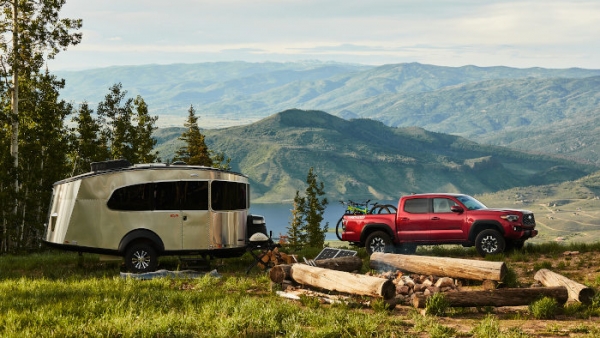Going off grid is a world away from staying at an RV resort like Crossing Creeks, which is designed to give you not only all the comforts of home, but also a few your home doesn’t have. Off-grid campsites, by contrast, offer ready access to nature but few of the creature comforts.
Here’s what an off-grid RV means in terms of features and capabilities:
Structure
An off-grid RV is likely to have bigger wheels and off-road tires, and a stronger frame than a model that experiences nothing more harsh than an occasional but well-traveled dirt or gravel road. The frame is a difference you don't see readily but one you must keep in mind if you’re comparing an off-grid unit to a similarly sized and featured RV that is intended for less rugged journeys.
Some manufacturers offer off-road packages. Airstream, for instance, offers the X-Package for its 16- and 20-foot Basecamp models. It includes more rugged wheels and tires, a 3-inch suspension lift, stainless steel rock guards, and a raised footpad for the trailer jack, further improving clearance.
Size
Off-grid towables tend to be tidy, if relatively full-featured. Length is usually 18 to 25 feet, with smaller units relying on one axle, and longer units having two. Many have enough head room for those standing 6 feet, 4 inches. Floor space typically allows a full kitchen and bathroom, plus sleeping accommodations for three or four—so the whole family travels.
There are some smaller off-road units out there. Forest River, for instance, offers 12-foot Rockwood Geo Pro in addition to longer models. The 12-footers have outdoor kitchens with a lift gate that shelters the chef. Less expensive models have interiors that are covered entirely by the bed for two. More upscale editions have sofas that fold out for sleeping.
Off-road trailers often have a higher ground clearance, about 15 inches between the road surface and the frame.
Weight
Like the lightweight travel trailer class, an off-grid, off-road RV is likely to be relatively lightweight so it’s easier to tow. A mid- or full-size crossover or SUV is probably capable of towing off-grid trailers, which often weigh less than 4,000 pounds.
That’s a big plus, since many potential buyers already own such vehicles. A base-class half-ton pickup truck, even with one of today’s 6-cylinder engines, is also likely up to towing these trailers.
Slideouts
Some models, such as the Winnebago Hike, have slideouts—one is standard on the Hike.
Others may expand interior space with a tip-out bed platform, as on the inTech Flyer. Those tip-outs, of course, are soft-sided, not a fully weather-protected hardshell as on a slideout. That means you get the space but maybe not quite the comfort, security or safety.
Know the rules for the types of places you’ll go. Some National Parks bar soft-covered RVs because of threats by wildlife. Check the rules before you buy.
More Fresh Water
Having enough fresh water is a major issue for off-grid RVers. Off-the-grid RVs tend to have bigger fresh-water tanks than similarly sized campers that are expected to be used mainly at campsites with full-service hookups. The Jay Feather Micro 166FBS, for example, has a 55-gallon fresh water tank—huge for a 19-foot trailer. Tanks bigger than 30 gallons are typical in off-gridders, but not automatic. Always check the specs.
Solar
To generate enough power off-grid, solar is a godsend. Noisy generators aren’t always welcome by campers—or neighbors—trying to experience natural tranquility and wildlife.
Not all off-grid RVs have solar, but most are prewired for it. Make sure the model you’re considering at least is prewired and ready for any solar equipment you install. Prewiring will save you time and make installation cheaper if you hire it out. You can probably buy installed solar as an option.
If roof-mounted equipment would block solar panels, you can always go with a portable system.
Appliances
Going off grid means goodbye to shore power, although the RVs have the connections if you need a night or two with a bit more comfort. Make sure your appliances use as little electrical power as possible. That means having a refrigerator that will will run on both 12-volt batteries and propane. Make sure your TV and connectivity equipment can run off 12-volt. Avoid power-thirsty home-grade appliances.
Cargo Capabilities
You’re going to want to explore, and that means taking along your outdoor toys—kayaks, trail bikes, dirt bikes, four-wheelers, whatever you prefer. Make sure you can do that with the trailer you buy.
The Hike has an exoskeleton that works like a good roof rack on an SUV. The Hike rack is even more versatile because it can accommodate attachments not only on the top of the trailer, but also on the front and rear.
The inTech RV Flyer lineup includes diminutive toy haulers. With its welded aluminum cage frame, a Flyer can haul up to 1,500 pounds of dirt bikes and four-wheelers and still withstand the rigors of off-road travel.
Confirm the Details
It's important to study the details when looking for an off-grid, off-road trailer. Don’t take the salesman’s word for it; check spec sheets from the manufacturer and call the builder’s customer service number to double-check on content of the trailer by giving the serial number.
